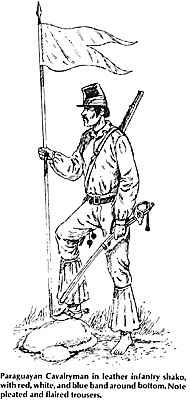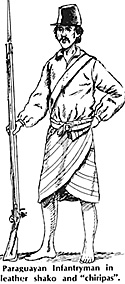PARAGUAYAN UNIFORMS
 Infantry: The basic infantry uniform consisted of a red pullover Gaucho-style shirt, sometimes with blue/black collar and cuffs. This was worn over a white cotton shirt. The headgear is described as being "like the French Imperial Guard".
Infantry: The basic infantry uniform consisted of a red pullover Gaucho-style shirt, sometimes with blue/black collar and cuffs. This was worn over a white cotton shirt. The headgear is described as being "like the French Imperial Guard".
Paraguayan Cavalryman in leather infantry shako, with red, white, and blue band around bottom. Note pleated and flaired trousers.
Illustrations indicate a truncated shako as worn by Napoleon III's Guard Voltigeurs. The shakowas either red with black trim or black with red trim, with the red seeming to predominate. Trousers were white. All enlisted men went barefoot. Equipment consisted of a waistbelt of black or white, a cartridge box carried on a black or white shoulder belt, and a bayonet carried fixed to the musket, no scabbard being provided. Paraguayan troops frequently wore a "chiripa" around theirwaists. Essentially this was oneor two ponchosworn wrapped about thewaist as a kilt. These could be most any color; variousstriped patterns seem popular. As the war progressed, the colored shako gave way to a leather copy, sometimes worn with a red, white, and blue ribbon tied around the base. Near the war's end the red shirts were restricted for officers' wear, with the men often appearing in only a leather cap, breechcloth, and musket.
Artillery: The Artillery seems to have worn the infantry uniform.
THE PARAGUAYAN ARMY
At the war's start, the Paraguayan Army consisted of about 60,000 men (this is an estiamte; some figures go as high as 100,000), or nearly 10% of the total population. Kolinski estimates that there were 48 infantry battalions of about 1,000 men each, divided into eight companies, of which one was designated grenadiers and one light. There were also 20-25 cavalry regiments, sixteen horse and eight foot batteries of artillery. There was also a small navy. At the war's start, a number of infantry units were actually overstrength. The large size of this army meant that Paraguay not only had virtually no reserve, but not even enough men to work necessary industry and agriculture; this of course fell to the women (who also served in military units).
Weaponry varied a great deal, much of it being obsolete cast-offs. The main infantry weapon was the .75-caliber, flintlock, smoothbore "Brown Bess". A few elite units had percussion rifle, and as the war went on a number of battalions were equipped with captured Brazilian and Argentine weapons. Cavalry units who had firearms were usually armed with smoothbore carbines, but their main weapons were the lance and a brass hilted saber, along with the South American bolo. Artillery was mainly outdated surplus, including some old Spanish pieces, though there were some modern guns. During the war great efforts were made to capture Brazilian rifled guns.
Two specialized organizations were the Chatas and the Canoe Paddlers Corps. The chatas were flat bottomed barges mounting an 8 inch gun with a 360 degree traverse in the center. They could be anchored close to shore where they were protected by mines (torpeclos) and shore
 Paraguayan Infantryman in leather shako and "chiripas".
Paraguayan Infantryman in leather shako and "chiripas".
Paraguay's greatest resource was in the common soldiers, generally recruited among the Guarani Indian population. These troops were fanatically devoted to Marshal Lopez, and apparently did not know the meaning of fear. Incidents of Paraguayan units running away are rare, while incidents of units literally being cut down to the last man are fairly common. Unfortunately, the officer corps was largely untrained and inexperienced, though in the main they were as brave asthe men. Some, such as General Diaz and Colonel Caballo, showed signs of greatness.
Engineers: There were no engineer units as such, but the 6th and 7th Infantry Battalions functioned as Pioneers.
Cavalry: The cavalry dressed basically like the infantry. Those with carbines wore them slung across their backs. The saber was carried in a brass scabbard. Like the infantry the cavalry was barefoot; the large spurs were strapped directly to the feet. Instead of a stirrup, a looped piece of rope was used. The trooper inserted his big toe in this loop. (This was a common method of riding for Gauchos of the period. Some writers commented that many could hardly walk due to their feet being deformed by this method of riding!)
Special Units: The Aca-Caraya ("Monkey-heads") Cavalry Regiment wore a leather helmet decorated with two monkey tails and a white horsehair plume. They also wore blue trousers and boots. The Aca-Vera ("Shining-heads") wore leather shakoes faced with brass. They also wore bluetrousers and boots. The elite infantry unit was the 40th ("Ascuncion") Battalion. It was raised among the best families of the capital and was destroyed no less than five times, being re-raised each time. No special uniforms are noted, but it would probably have been better equipped than normal.
Officers: During his trip to France, Lopez ordered uniforms for his officers. These were almost identical to French uniforms, being blue with gold rank insignia. Obviously, these made very good targets of the officers wearing them.
NOTE: As was noted earlier, most Paraguayan soldiers were of Guarani Indian or Mestizo stock. They were generally fairly short and stocky with straight black hair and mustaches. After the first months of the war, Paraguay's supply situation was chaotic (or non-existant); much worse than the Confederacy's in our Civil War. Uniforms and weapons were replaced with local substitutes, or items captured from the Allies. Whole battalions wore Brazilian and Argentine uniforms. Any comments on uniforms should be taken as very general.
More Paraguayan War 1865-70
- Background
Major Battles of the War
Paraguayan Uniforms and Army
Brazillian Uniforms and Army
Argentinian Uniforms and Army
Uruguay and Naval Aspects
Wargaming Applications
Back to Table of Contents -- Courier Vol. VII #2
To Courier List of Issues
To MagWeb Master Magazine List
© Copyright 1986 by The Courier Publishing Company.
This article appears in MagWeb (Magazine Web) on the Internet World Wide Web.
Other military history articles and gaming articles are available at http://www.magweb.com